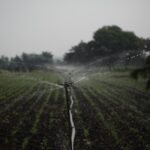Long-term water shortage management and Proposed Solutions and Conservation Efforts explained
Long-term water shortage management for California: Parts of the Sierra Nevada Range and adjacent desert areas experience water shortages
The Active Climate Rescue Initiative: A Beacon of Hope for the Great Basin
The Great Basin: A Vital Landscape Facing a Challenge
The vast, dry region of the Great Basin, encompassing parts of Nevada, Utah, Oregon, California, and Idaho, faces a growing water shortage. This precious resource, the lifeblood of the ecosystem and its communities, is dwindling due to climate change and increasing demands.
The Active Climate Rescue Initiative: Embracing Innovation for a Sustainable Future
The Active Climate Rescue Initiative stands as a beacon of hope, dedicated to finding solutions to this pressing challenge. We believe that by embracing innovative solutions and working together, we can overcome the water shortage and create a more sustainable future for the Great Basin.
Water Wisely: A Future of Abundance
One key strategy is embracing innovative irrigation techniques. Drip irrigation, for example, delivers water directly to plant roots, minimizing waste and maximizing efficiency. By adopting these methods, farmers can conserve water, ensure healthy crops, and support the region’s agricultural economy.
Together, We Can Make a Difference
The Active Climate Rescue Initiative invites you to join us in this mission. Through collaboration, education, and action, we can restore the balance of the Great Basin’s water cycle and secure a thriving future for generations to come.
Let’s work together to ensure a future where the Great Basin thrives, its resources are protected, and its communities prosper.
The Great Basin’s Thirst: A Look at Water Shortages and Solutions
TL;DR: The Great Basin is a dry region that faces serious water shortages. Climate change is making the problem worse, and we need to find ways to conserve water and use it more wisely.
The Great Basin’s Water Cycle: A Balancing Act
The Great Basin is a vast, dry region in the western United States, covering parts of Nevada, Utah, Oregon, California, and Idaho. Imagine a big, shallow bowl where water collects, but the water can’t escape! That’s kind of like the Great Basin.
How Water Moves Through the Region
The Great Basin gets most of its water from snow that falls on the mountains. The snow melts in the spring, and the water flows down rivers and streams. This water can be used by people, animals, and plants. Some of the water sinks into the ground, and becomes groundwater. This water can be used from wells. Some water evaporates back into the air, and starts the cycle again.
A Delicate Balance
The Great Basin is a fragile ecosystem. The amount of water available is always changing, depending on how much snow falls each year. If there’s less snow, there’s less water. This can lead to droughts, and make it hard for people, animals, and plants to survive.
The Challenges of Water Shortages in the Great Basin
The Great Basin is facing a growing water shortage problem. Here’s why:
Climate Change: A Growing Threat
The climate is changing, and this is making the Great Basin even drier. Temperatures are getting hotter, and the snowpack is melting earlier in the spring. This means that there’s less water available for people, animals, and plants.
Water Scarcity: A Looming Crisis
Water scarcity is a big problem for the Great Basin. As the population grows, more water is needed for drinking, irrigation, and other uses. The growing need for water makes the shortage even worse.
Finding Solutions for a Thirsty Region
There are many things that people can do to address the water shortage in the Great Basin. Here are some ideas:
Water Conservation: Saving Every Drop Counts
Conservation is key! Everyone can help by using less water in their homes, yards, and businesses. Here are some ideas:
- Take shorter showers.
- Fix leaky faucets.
- Water your lawn less often.
- Use water-efficient appliances.
Innovative Irrigation: Using Water Wisely
Farmers can use less water by using new irrigation techniques like:
- Drip irrigation: This system delivers water directly to the roots of plants, so less water is wasted.
- Water-efficient crops: Some crops need less water than others. Farmers can choose to plant crops that require less water.
Policy Measures: Working Together to Solve the Problem
Governments and communities need to work together to find solutions. This might mean:
- Setting water use limits.
- Investing in water conservation projects.
- Protecting water resources.
The Active Climate Rescue Initiative: Making a Difference
The Active Climate Rescue Initiative is dedicated to solving the water shortage problem in the Great Basin. They’re working on projects that focus on water conservation, renewable energy, and sustainable agriculture.
Summary: A Collaborative Effort for a Sustainable Future
The Great Basin is facing a serious water shortage problem. This is a complex issue that requires a multi-pronged approach. Through conservation efforts, innovative irrigation techniques, and policy measures, communities can work together to ensure a sustainable future for the Great Basin. Organizations like the Active Climate Rescue Initiative are playing a crucial role in finding solutions and preserving this vital region for generations to come.
More on Long-term water shortage management…
- ## SEO Keywords: Long-term Water Shortage Management & Solutions
- General Keywords:
- long-term water shortage
- water scarcity management
- drought management strategies
- sustainable water management
- water conservation efforts
- water security solutions
- water resource planning
- water crisis solutions
- climate change and water scarcity
- future of water resources
- Proposed Solutions and Conservation Efforts:
- water efficiency technologies
- water recycling and reuse
- rainwater harvesting
- greywater systems
- water-wise landscaping
- drip irrigation systems
- desalination plants
- water infrastructure development
- water pricing policies
- water conservation programs
- water education and awareness
- drought-resistant crops
- water-efficient appliances
- smart water meters
- water leakage detection
- water auditing
- water footprint reduction
- virtual water trade
- Region-specific Keywords:
- [Specific Region] water shortage
- [Specific Region] drought management
- water scarcity in [Specific Country]
- [City/State] water conservation efforts
- [River Basin] water management plan
- Target Audience Keywords:
- water management for farmers
- water conservation for businesses
- urban water management
- residential water conservation
- water resources for communities
- water crisis solutions for governments
- sustainable water management for industries
- Additional Keywords:
- water shortage statistics
- water scarcity impact
- global water crisis
- water footprint calculator
- water conservation tips
- water resources management software
- water conservation grants
- water shortage news
- water scarcity research
- Long-Tail Keywords:
- best practices for long-term water shortage management
- how to conserve water in a drought
- innovative solutions for water scarcity
- water scarcity solutions for developing countries
- water management for future generations
- the role of technology in water conservation
- impact of climate change on water resources
- financing water infrastructure projects
- water conservation for a sustainable future
- water shortage and food security
- water scarcity and social equity
- the human cost of water shortage




